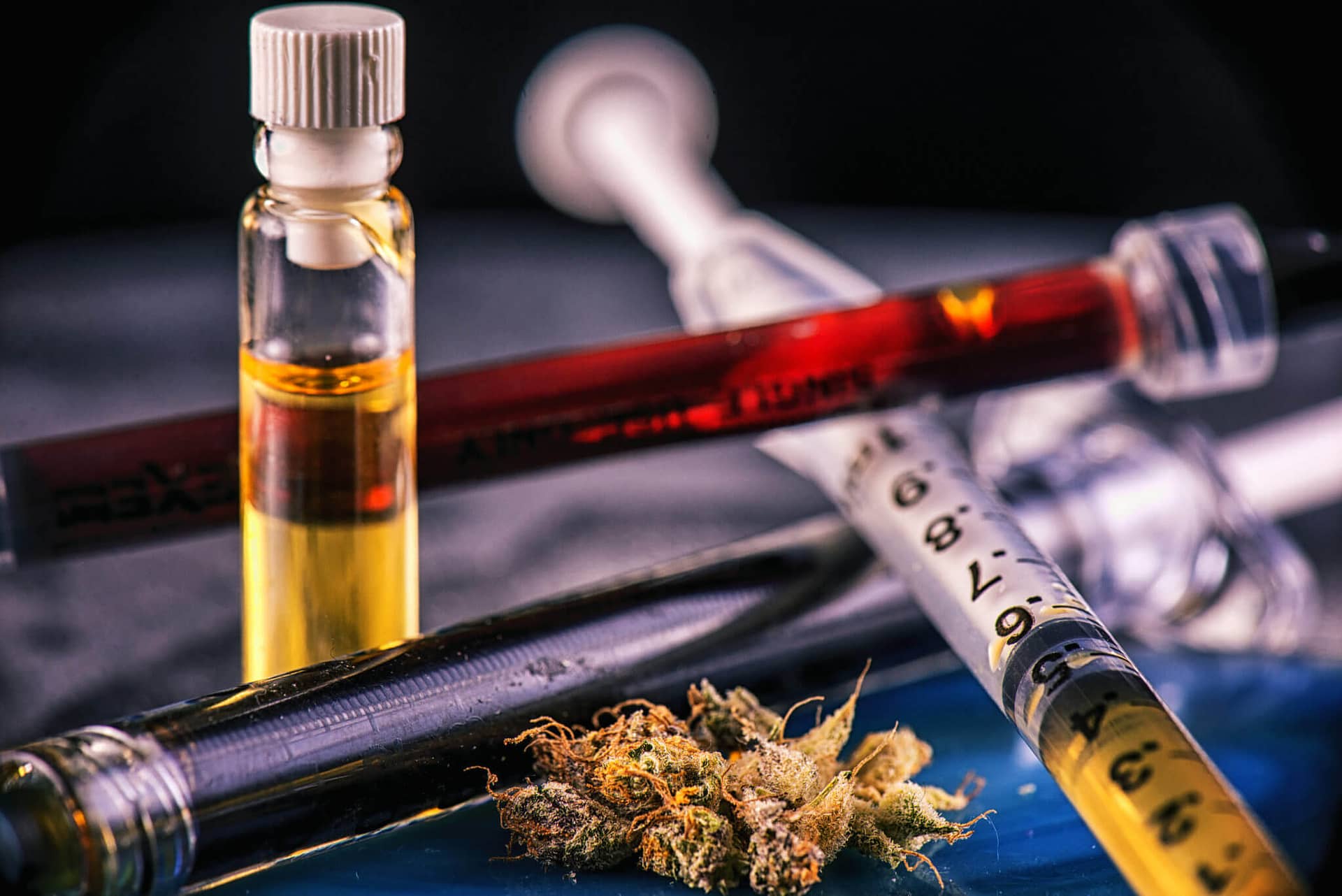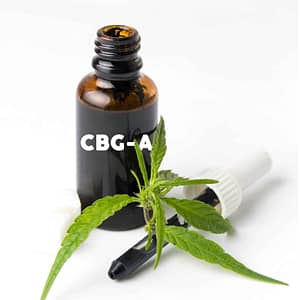Cannabinoids

 Cannabigerol Acid (CBG-a)
Cannabigerol Acid (CBG-a)
A small amount of scientific research on cannabinoids has been carried out so far, so we are still trying to understand the interaction of cannabinoids and the endocannabinoid system.
So far, cannabinogerol acid is commonly referred to as the “cannabinoid stem cell”. CBG-A is the first to be formed in a plant, what makes it a precursor of other cannabinoid acids (such as CBD-A, THC-A, CBC-A, THCV-A).
CBG-A supports the fight against cancer through its anti-proliferative capabilities. Just like other cannabinoids formed from CBG-a, cannabigerol acid supports fighting apoptosis, which is a cell death considered to be a frequent cause of cancer progression.
Researchers reveal that cannabinoids based on cannabigerol acid stimulate apoptosis in an unprecedented way, giving hope to find a cure for cancer.
Cannabigerol acid is also used as a painkiller, ensuring the comfort of life among terminally ill patients and as an antibacterial compound that inhibits bacterial growth. Patients admit that the systematic use of cannabigerol acid helps to reduce inflammation.
Research has shown that cannabis plant geneticists are able to achieve the highest levels of cannabigerol acid in cannabis plants at the level up to 94%. This high concentration is caused by inhibition of synthesis by the recessive gene in the plant.

 Cannabidiol Acid (CBD-a)
Cannabidiol Acid (CBD-a)
The highest level of CBD-A is found in young cannabis plants and has no psychoactive effect. Cannabidiol acid is converted to CBD after cutting, drying and heating the plants under the process of decarboxylation.
A small amount of scientific research on cannabidiol acid has been carried out to this day. However, the results of a few studies and patients’ observations indicate the therapeutic use of this cannabinoid.
CBD-A proves to be effective in reducing inflammation. According to the results of the experiment published in 2008 called ‘Drug Metabolism and Disposition’, cannabidiol acid proved to be a selective inhibitor of the COX-2 enzyme playing an important role in the development of pro-inflammatory compounds called prostaglandins, found in aspirin or ibuprofen.
CBD-A is able to relieve nausea and vomiting better than decarboxylated cannabidiol. Young plants appear to be more helpful in alleviating nausea and nervousness of the stomach in rodents, which was confirmed by a study from 2012 published in the British Journal of Pharmacology.
Cannabidiol acid enhances the effect of other cannabinoids in treating cancer. A study from 2012 showed that CBD-A is able to effectively stop the migration of breast cancer cells in laboratory conditions on Petri dishes. Despite the lack of documented clinical trials on humans, CBD-A showed a positive effect on stopping cancer from developing and preventing the migration of cancer cells to other organs of the body.
We don’t have results of detailed studies on the use of cannabidiol acid in the treatment of psychosis yet, but we know, that the biopharmaceutical companies are conducting them on an increasing scale. The British corporation GW Pharmaceuticals has already decided to include the CBD-A in a patent application for the use of cannabinoids in combination with antipsychotic drugs.
CBD acid blends in with a diet rich in juices, cocktails, as well as salads and salad dressings.

 Tetrahydrocannabinol Acid (THC-a)
Tetrahydrocannabinol Acid (THC-a)
Tetrahydrocannabinolic acid known as THC-A is a compound found in cannabis plants. Along with the development of scientific research, we are learning about the increasing therapeutic potential of THC-A. Psychoactive effect appears, when the plant is mature or cut and THC-A is converted to THC through a decarboxylation process.
There isn’t enough research on THC-A, that would allow us to clearly determine its properties and dosage. Studies carried out so far indicate anti-inflammatory properties used in the treatment of arthritis.
THC-A has also neuroprotective properties that turn out to be effective in treating neurodegenerative diseases such as Alzheimer’s and Parkinson’s.
Prostate cancer research has revealed the additional use of tetrahydrocannabinol acid associated with its antiproliferative properties.
Patients indicate that THC-A helps them fight insomnia and pain.
Studies show that tetrahydrocannabinol acid helps to relax muscle spasms, which is why it’s used by people struggling with muscle spasticity.
The highest level of THC-A is found in young, living or freshly harvested plants. Any cannabis strain with a high concentration of THC that hasn’t yet been decarboxylated contains a lot of THC-A.
Some products are sold specifically for the properties of THC-A, which provides THC benefits without the risk of psychoactive effects.
Research into the effects of this cannabinoid is ongoing.

 Cannabichromic Acid (CBC-a)
Cannabichromic Acid (CBC-a)
Cannabichromic acid (CBC-a) is considered one of the major cannabinoids found in cannabis.
The highest concentration of CBC-A is found in tropical cannabis varieties, but it is present at various levels in most Cannabis strains.
The development of knowledge about cannabis plant genetics has allowed them to obtain special strains with increased CBC-A content.
Very little research has been done on cannabichromene acid so far. However, the researchers point out that CBC-A may have anti-inflammatory and antibacterial properties.
It’s believed that cannabichromic acid is formed in the early stages of plant development. It appears even in small seedlings much earlier than THC is produced.
CBC-A doesn’t show psychoactive properties and can be transformed into cannabichromene (CBC) as a result of decarboxylation, i.e. exposure to air, light and heat.

 Kannabidiol (CBD)
Kannabidiol (CBD)
Kanabidiol is one of the two most important cannabinoids discovered in cannabis plants. It occurs in varying proportions in different strains and its level can be controlled along with scientific progress in the field of cannabis plant genetics.
Currently, more and more extensive research on CBD with a varied level of evidence quality is being conducted.
Cannabidiol has no psychoactive properties, and as an antagonist of the CB1 and CB2 cannabinoid receptors it eliminates the psychoactive effect of THC.
Research suggests that cannabidiol can be effective in the treatment of chronic and neuropathic pain. It also appears that CBD has anti-inflammatory properties, reducing pain associated with inflammation.
At the same time, CBD may also be an immuno-modulator and an antioxidant.
Cannabidiol is known to have anticonvulsant properties, supporting the treatment of epilepsy. Patients indicate a decrease in the frequency and severity of epileptic seizures and indicate improvement in well-being, sleep quality and concentration.
Many users, including cancer patients undergoing chemotherapy, confirm that CBD has helped them fight nausea and vomiting. Studies conducted by the Complutense University of Madrid have shown the death of cancer cells under the influence of cannabinoids. Patients show an improvement in well-being, a sense of elimination of chronic fatigue and a reduction of pain.
Cannabidiol proves to be helpful in treating disorders associated with the autism spectrum. A study by Stanford University Medical School in 2013 showed that neuroglin-3, a protein that is mutated in some cases of autism, helps in the transmission of signals between neurons and the endocannabinoid system.
CBD is currently used as a neuroprotective component in treating the symptoms of neurodegenerative diseases such as Alzheimer’s and Parkinson’s. Cannabidiol relieves stress, anxiety and inflammation, reduces oxygen accumulation and stimulates the brain.
Despite the lack of scientific evidence confirming their words, patients suffering from chronic inflammatory bowel diseases, such as Crohn’s disease and ulcerative colitis exchange the benefits of using CBD. Their influence on the stabilization of homeostasis in the large intestine allows them to maintain the balance of the digestive system in terms of electrolytes, bacteria and the level of absorption and release of fluids.
Patients suffering from multiple sclerosis confirm the effectiveness of CBD in relieving stiffness and muscle spasticity, alleviating pain associated with the disease. Scientific research at the University of Tel Aviv seems to confirm this at a time when CBD has helped paralyzed mice recover their ability to walk, reducing the amount of nerve cell damage and inflammation, especially in the brain and spine.
CBD is increasingly used as a support in treating addictions, reducing the need for heroin, cocaine and alcohol. Cannabidiol is also considered as antipsychotic, helping people suffering from anxiety and anxiety.
Basing on its therapeutic values, CBD is already recommended in some countries as a beneficial dietary supplement. People using CBD confirm that it helps them reduce stress and negative cognitive symptoms such as forgetting or distracting.
Specialists advise that the CBD dosage should start from about 2-3 mg taken every 6 hours. Long-term therapy is associated with the need to maintain a constant level of CBD in the body, remembering that the molecule decomposes after 6 hours. The dose of 2-3 mg, however, is very indicative and depends to a large extent on the concentration of the product containing CBD, the content of other cannabinoids, age, weight and other body characteristics of the patient, as well as on the disease the patient is struggling with.

 ∆-9-Tetrahydrocannabinol (THC)
∆-9-Tetrahydrocannabinol (THC)
Tetrahydrocannabinol is the most popular and best-known cannabinoid found in cannabis. It was first isolated in 1964 by the chemist Raphael Mechoulam, what intensified research on this compound.
Tetrahydrocannabinol binds to cannabinoid receptors CB1 and CB2 found in the human body, primarily in the brain, demonstrating psychoactive effects. Therefore, tetrahydrocannabinol is illegal in many countries in the world.
The appropriate dose of tetrahydrocannabinol is unknown and depends on the disease and body of each patient. As it comes with any cannabinoid, it’s best to start with a low dosage and increase it until effects are achieved.
The research on THC has shown that this compound supports the fight against cancer by treating nausea and vomiting caused by chemotherapy. Patients claim, that using tetrahydrocannabinol brings them relief from pain.
Some studies indicate that THC can cure neuropathic pain caused by nerve damage and minimize the consequences of HIV infection.
Results of the studies and patients’ personal stories confirm that tetrahydrocannabinol is also effective in treating PTSD symptoms. THC helps them in reducing chronic stress and anxiety. Cannabis brings relief from extremely realistic nightmares and supports insomnia treatment. However, each patient is unique and the suggested dose is individual. Conventional, pharmacological PTSD treatment is usually associated with an increase of serotonin level in the brain. However, some studies don’t show any significant differences between the experimental group and the placebo one.
Doctors of patients suffering from Crohn’s disease and researchers noticed the effect of tetrahydrocannabinoid on significant alleviation of disease symptoms and improvement of patients’ life quality.
THC may prove to be an effective remedy for ADHD, because dysfunctions in the body’s endocannabinoid system may be the primary cause of attention deficit hyperactivity disorder. THC is known for the effect of relaxation and calm, as well as improved focusing, which turns out to be a perfect solution for people suffering from ADD and ADHD.
Tetrahydrocannabinol is used to save and improve the quality of patients’ lives. The research on cannabis continues to be carried out and brings more information about medicinal values of this plant.

 Cannabigerol (CBG)
Cannabigerol (CBG)
Cannabigerol (CBG) is a cannabinoid that doesn’t have any psychoactive effects and that is present in small amounts (usually less than 1%) in most of cannabis strains.
Cannabis plants produce cannabigerol acid (CBGA), which is a precursor to the three main cannabinoid lines: tetrahydrocannabinol acid (THCA), cannabidiol acid (CBDA) and cannabigerol acid (CBCA). Enzymes in cannabis convert CBGA into THCA or CBDA, which decarboxylate under the influence of light or thermal energy to produce THC or CBD.
Obtaining a higher content of CBG in the plant is today possible thanks to experiments related to genetic manipulation and plant crossing. Researchers can also receive higher levels of CBG from young plants.
Endocannabinoid receptors found in the eye structure allow CBG to relieve symptoms and treat glaucoma due to its effects lowering the intraocular pressure.
Experiments on mice have shown that CBG is also effective in reducing inflammation that is typical for inflammatory bowel disease.
Cannabigerol is also able to dilate blood vessels and act neuroprotectively. Research from 2015 is showing that CBG protects neurons of mice suffering from Huntington’s disease, characterized by degeneration of nerve cells in the brain.
CBG is becoming an increasingly promising solution for people struggling with cancer. Cannabigerol used on mice has blocked the receptors allowing the colon and rectal cancer cells to grow.
European studies show that CBG is also an effective antibacterial compound.
A study on rats conducted in 2017 showed that products containing CBG that had been deprived of THC proved to be an effective appetite stimulator. This opens up the possibility of using a non-psychoactive option of cannabinoid therapy. The study also examined the effect of five different cannabinoids on bladder contractions and CBG showed the best results associated with inhibition of muscle contractions. In the future, it may help to prevent many bladder disorders.
CBG is also used as an analgesic and anti-depressant.
Researchers are working on discovering more effects of the CBG.

 Tetrahydrocannabivawine (THCV)
Tetrahydrocannabivawine (THCV)
Tetrahydrocannabivarine is a very abundant cannabinoid containing 19 carbon atoms, 26 hydrogen atoms and 2 oxygen atoms, typical for phytocannabinoids.
The initial reaction in the plan produces a cannabigovaric acid, also known as CBGVA. This new substance reacts with THCV synthase, an enzyme and forms THCVA (tetrahydrocannabivaricarboxylic acid). Finally, THCVA decomposes into THCV by decarboxylation.
THCV is not yet fully studied, but we know that it has a psychoactive effect only at high doses, like CBN.
At low doses, THCV is a CB1 receptor antagonist. Increasing the dose of THCV, however, strengthens the psychoactive effect of THC.
THCV affects the body by binding to receptors located in the immune system, major organs and the brain.
Unlike tetrahydrocannabinol, THCV affects appetite suppression. Therefore, THCV effectively supports not only weight loss, but also reduces appetite among people struggling with diabetes.
A study published in 2009 showed the effect of THCV on the reduction of swelling and pain in mice due to anti-inflammatory effects. Mice participating in the study did not increase THCV tolerance after 4 days of testing.
Studies have also shown that THCV is able to reduce or even eliminate panic attacks, enabling treating PTSD and other anxiety disorders.
Studies have also shown that THCV affects the reduction of convulsions associated with Parkinson’s disease. This compound may also stimulate bone growth, supporting the treatment of osteoporosis.
THCV also reduces seizures among people struggling with epilepsy.

 Cannabichromene (CBC)
Cannabichromene (CBC)
Cannabichromen (CBC) is one of the least-studied cannabinoids, even though it’s the third largest cannabinoid occurring in cannabis plants, just after THC and CBD.
Cannabichromen binds to CB1 and CB2 receptors, but also interacts with other receptors, in particular TRPA1 and TRPV1, which are playing a key role in the transmission of pain and inflammatory signals to other parts of the body. Although, it’s believed that CBC has no psychoactive effect.
Research from the 1970s has shown that Cannabis strains from India have a higher CBC level, which often turns out to be more abundant than the level of CBD. Higher CBC concentration occurs in young plants. Over time, it breaks down into a cannabinoid called cannabicycol.
Cannabichromen is considered a compound with anti-inflammatory, analgesic and antibacterial properties.
A research conducted by the University of Mississippi has shown that CBC supports the reduction of chronic stress and depression.
Researchers have also noticed the effect of CBC on reducing neurogenesis, Alzheimer’s, Parkinson’s, Huntington’s diseases.
A study published in 2016 by the Journal for Experimental Dermatology showed that CBC has properties that help fighting acne. CBC seems to reduce the production of sebum by the sebaceous glands, while reducing the effect of arachidonic acid on the skin and glands.
Currently, most of hemp treatments have been optimized for high CBD and THC content at the lower cost of cannabichromen. However, CBC works better in combination with THC and CBD simultaneously.

 Cannabinol (CBN)
Cannabinol (CBN)
CBN is a mild psychoactive substance found in Cannabis plants, which is created as a result of THC degradation. Cananbinol can be found in mature and harvested plants and its concentration increases with the storage time.
Tetrahydrocannabinol acid (THC-A) is converted to CBN-a as a result of exposure to air for a long time. THC-a then loses its hydrogen molecules due to oxidation. The acidic form of CBN (CBN-a) transforms into CBN as a result of exposure to UV light and heat.
Science doesn’t yet fully answer the questions about properties of any cannabinoid. It is believed that CBN reduces the potency of THC by being a partial antagonist of CB1 and CB2 receptors. While CBD influences directly the endocannabinoid system (ECS) to block the production of anandamide, CBN is only produced by exposing the harvested plant to air and by subsequent degradation of THC.
CBN is in many cases used for its calming effects that help treating insomnia.
Cannabinol affects certain immune cells to perform anti-inflammatory effects without interacting with the CB2 receptor by modulating levels of endocannabinoids. CBN is even able to affect the levels of other compounds known to cause inflammation.
Cannabinol is considered to be an anticonvulsant. It affects the reduction of seizures at levels comparable to THC and CBD.
Research on rats has shown that CBN can also increase an appetite.




